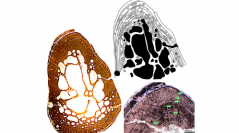

 Comptes Rendus Palevol
16 (4) - Pages 425-439
Comptes Rendus Palevol
16 (4) - Pages 425-439Bone histology is an important tool for uncovering life history traits of extinct animals, particularly those that lack modern analogs, such as the non-avian dinosaurs. In most studies, histological analyses preferentially focus on long bones for understanding growth rates and determining age. Here we show, by analyzing ornithischians (a stegosaur and an ornithopod), saurischians (a sauropod and a theropod), and a crocodile, rib histology is a suitable alternative. The estimated age for all sampled taxa ranges between 14 to 17 years for Lourinhanosaurus antunesi and 27 to 31 years estimated for Draconyx loureiroi. The theropod Baryonyx was skeletally mature around 23–25 years of age but showed unfused neurocentral sutures, a paedomorphic feature possibly related to aquatic locomotion. Our results show that ribs can contain a nearly complete growth record, and reveal important information about individual age, point of sexual maturity, and, in some cases, sex. Because ribs are more available than long bones, this method opens new possibilities for studying rare and incomplete fossils, including holotypes.
New histological approach for ribs, Determination of ontogenetic stage, Skeletal maturity, Age at first reproduction, Longevity in dinosaurs